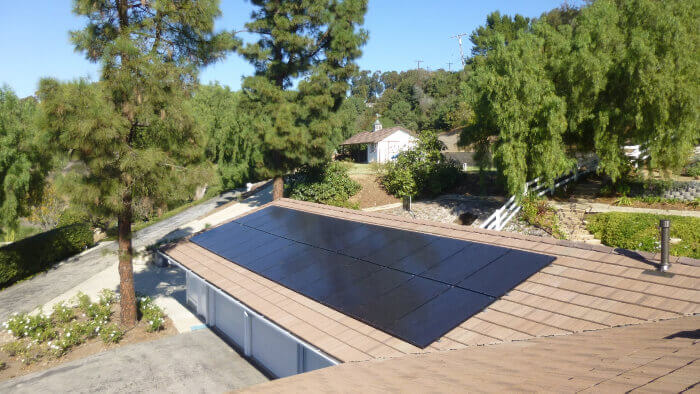Solar Power in California
California continues to lead the nation in solar adoption thanks to its sunny climate, renewable energy policies, and strong homeowner interest. Going solar can help reduce your utility bills, increase your home’s value, and lower your carbon footprint.
In this guide, we’ll walk through the solar panel price in California, available rebates and tax incentives, new net metering rules, and the best solar companies in the state. You’ll also find answers to common questions about switching to solar in 2025.
Cost of Solar Panels in California
The average solar panel price in California is about $16,500 before incentives. Most homeowners spend between $12,000 to $22,000 depending on the size of the system, equipment, and installation details.
Costs can also vary by city. Here’s what homeowners typically pay in some of California’s largest metro areas:
| City | Average Solar Panel Cost |
|---|---|
| Los Angeles | $16,800 |
| San Diego | $16,200 |
| San Jose | $17,300 |
| Fresno | $15,700 |
| Sacramento | $16,400 |
These estimates are averages and do not include rebates, tax credits, or other savings.
California Solar Programs, Rebates, and Incentives
California offers one of the strongest mixes of solar programs and incentives in the country. Together, these benefits make solar more affordable and help many homeowners achieve a return on investment (ROI) in about 6 to 9 years.
Below are the key programs available in 2025. Each works differently, but all provide opportunities for savings.
Self-Generation Incentive Program (SGIP)
The Self-Generation Incentive Program (SGIP) provides rebates for installing solar battery storage. Homeowners can reduce their reliance on the grid, cut peak-time energy costs, and gain backup power for outages. Rebate amounts vary based on battery size and income eligibility, with savings often reaching several thousand dollars. SGIP is currently active with no set expiration date.
Disadvantaged Communities — Single-Family Solar Homes Program (DAC-SASH)
The original Single-Family Solar Homes (SASH) program has ended, but the DAC-SASH program is active through 2030. It provides upfront rebates for income-qualified homeowners in disadvantaged communities across California’s major utility territories. For eligible families, these incentives can cover a significant portion of solar installation costs.
Property Assessed Clean Energy (PACE) Programs
PACE programs allow homeowners to finance solar projects through their property taxes, spreading payments out over time. Because the loan is tied to the property — not the homeowner — PACE financing can sometimes transfer when a house is sold. While not a rebate, it makes solar more accessible by reducing upfront costs. However, there are some drawbacks to PACE:
- Property Tax Lien: PACE loans are attached to your property tax bill, not your mortgage. This creates a lien on your home that takes repayment priority over your mortgage lender.
- Impact on Selling or Refinancing: Because the lien stays with the property, selling your home can be harder unless the buyer agrees to take over the PACE obligation. Some mortgage lenders may also refuse to refinance until the lien is paid off.
- Higher Interest Rates: PACE financing often carries higher interest rates compared to traditional solar loans, which can increase the overall project cost.
- Upfront Fees: PACE programs may include administrative fees or recording costs that raise the total amount financed.
- Limited Consumer Protections: Although California has strengthened oversight, PACE loans historically had fewer consumer protections than traditional financing, leading to cases of homeowners taking on unfavorable terms.
- Availability Varies: Not all counties or cities in California participate, so eligibility may be limited depending on your location.
Power Purchase Agreements (PPAs)
A Power Purchase Agreement allows homeowners to install solar panels with little or no upfront cost. Instead of owning the system, you pay for the electricity it produces at a rate typically lower than your utility. Savings depend on your household’s energy use, time-of-use rates, and contract terms.

Renewable Energy Laws and Standards in California
While not direct rebates, California’s renewable energy laws set the stage for strong solar adoption:
- Renewables Portfolio Standard (RPS): Requires utilities to supply 60% renewable electricity by 2030.
- SB 350 (Clean Energy and Pollution Reduction Act): Expands renewable and efficiency targets, doubling statewide efficiency savings by 2030.
- SB 100 (100% Clean Energy Act): Commits California to 100% clean electricity by 2045.
These laws indirectly benefit homeowners by supporting long-term investment in renewable infrastructure and distributed solar.
Property Tax Exclusion
California’s Revenue and Taxation Code provides a property tax exclusion for solar energy systems and eligible storage. Homeowners do not pay additional property taxes on the increased value solar adds to their home. The exclusion applies to 100% of a system’s value (or 75% for dual-use equipment) and is set to expire on Jan. 1, 2027.
California Grants for Home Improvement
Direct grants for residential solar are generally not available statewide. Some local governments may offer targeted assistance, but most solar support comes through rebates, loans, and tax credits. Homeowners should check with city or county programs for location-specific opportunities.
California Home Improvement Loans
Low-interest financing programs are available to help homeowners cover the cost of solar and storage. For example, the state’s GoGreen Home program, supported by the California Alternative Energy and Advanced Transportation Financing Authority (CAEATFA), partners with lenders to offer affordable loans. These loans reduce upfront costs and can be bundled with other home energy improvements.
Expiring Soon: Federal Tax Credit
The Residential Clean Energy Tax Credit allows homeowners to deduct 30% of solar installation costs from federal taxes. This applies to both new and existing homes, including second residences (but not rentals).
The credit is set to expire on Dec. 31, 2025. After that, homeowners will no longer be able to claim it. Acting now ensures you lock in maximum savings.
Requirements include:
- The system must meet fire and electrical code requirements.
- The home must be located in the United States.
- Both principal and secondary residences qualify.
Net Metering in California
Net metering allows homeowners to earn credits for the excess electricity their solar panels generate and send back to the grid. These credits are applied against your utility bill, helping offset your energy costs.
In April 2023, California adopted new rules known as Net Billing Tariff (NEM 3.0), which replaced the state’s earlier net metering programs (NEM 1.0 and NEM 2.0).
What Changed Under NEM 3.0
- Lower Export Rates: Homeowners are now credited for exported energy at the utility’s avoided-cost rate, which is generally much lower than retail electricity rates. Credit values also vary by time of day and season.
- Grandfathering: Existing NEM 1.0 and NEM 2.0 customers keep their original terms for up to 20 years from their interconnection date.
- Incentive to Pair with Storage: Because export rates are lowest during midday, homeowners benefit most when they install solar with battery storage.
What It Means for Homeowners
While standalone solar still provides savings, the new rules make solar + storage systems more valuable. Homeowners can increase self-consumption, reduce reliance on grid power, and maximize long-term savings by shifting their stored energy use to high-rate periods.
Best Solar Companies in California
California is home to some of the nation’s top solar companies. The following providers are among the most widely available in the state, with options ranging from full ownership to leases and PPAs.
| Company | Average Cost | Pros | Cons |
|---|---|---|---|
| Sunrun | $15,000 to $30,000 | Large service area, financing options | Long-term contracts |
| Momentum | $20,000 to $25,000 | Strong warranties, energy monitoring | Limited regional availability |
| Palmetto Solar | $13,000 to $23,000 | Tech-driven monitoring app | Mixed customer reviews |
| SunPower | $18,000 to $30,000 | Very high panel efficiency, strong warranties, long experience in CA; local presence | Sometimes higher prices than budget competitors; recent corporate changes may affect customer service |
| Semper Solaris | $14,000 to $24,000 | Strong reputation for quality, good customer service; full-service solar + roofing; localized to Southern California | Premium pricing; service area concentrated in Southern CA |
| Freedom Forever | $13,000 to $22,000 | Good production guarantees, local installers, strong support; good installer rankings in CA | Fewer financing options in some areas; customer reviews vary by region |
| Solar Optimum | $12,000 to $20,000 | Local installer reputation, favorable reviews (EnergySage #1 Installer of the Year), high customer satisfaction | Equipment/design options may be limited compared to national players; possible wait times depending on demand |
Fresno
Homeowners in Fresno often work with Sunrun, Momentum, and Palmetto Solar. These providers offer competitive pricing, financing options, and reliable warranties in the Central Valley.
Bakersfield
In Bakersfield, Sunrun, Momentum, and Palmetto Solar are among the most popular options. Each offers strong warranties and financing choices that fit local homeowner needs.
San Diego
San Diego residents frequently choose Sunrun, Palmetto Solar, and Momentum. These companies have a strong presence in Southern California and provide options for both ownership and financing.
Sacramento
Sacramento homeowners often turn to Sunrun, Momentum, and Palmetto Solar. These providers have reliable warranties, energy monitoring options, and established service in the region.
FAQ: Going Solar in California
Is California paying people to go solar?
While California does not directly pay homeowners to install solar, there are valuable rebates, incentives, and tax credits that reduce costs significantly.
Who is the most reputable solar company in California?
Several companies, including Sunrun, Blue Raven Solar, and Trinity Solar, have strong reputations in California for quality installations and customer service.
How much do solar panels cost for a 2,000-square-foot house in California?
A 2,000-square-foot home typically requires a system costing between $15,000 to $20,000 before incentives, depending on energy use and equipment.
Is it still worth getting solar in California?
Yes. Even with changes to net metering, solar remains a smart investment in California due to high utility rates, tax credits, and long-term energy savings.
Does the state of California pay for solar panels?
California does not cover the full cost of solar panels. However, programs like SGIP, SASH, and property tax exclusions make solar more affordable.
Conclusion
Solar energy in California remains one of the best investments homeowners can make in 2025. With strong incentives, reduced installation costs, and a wide choice of providers, you can lower your bills and increase your home’s value. Taking advantage of federal and state programs now ensures you maximize your savings before certain incentives expire.
Compare top-rated solar pros in your area.
Read real homeowner reviews, explore qualifications, and view promotions. Modernize makes it easy to browse professionals and find one that will be perfect for your project.










